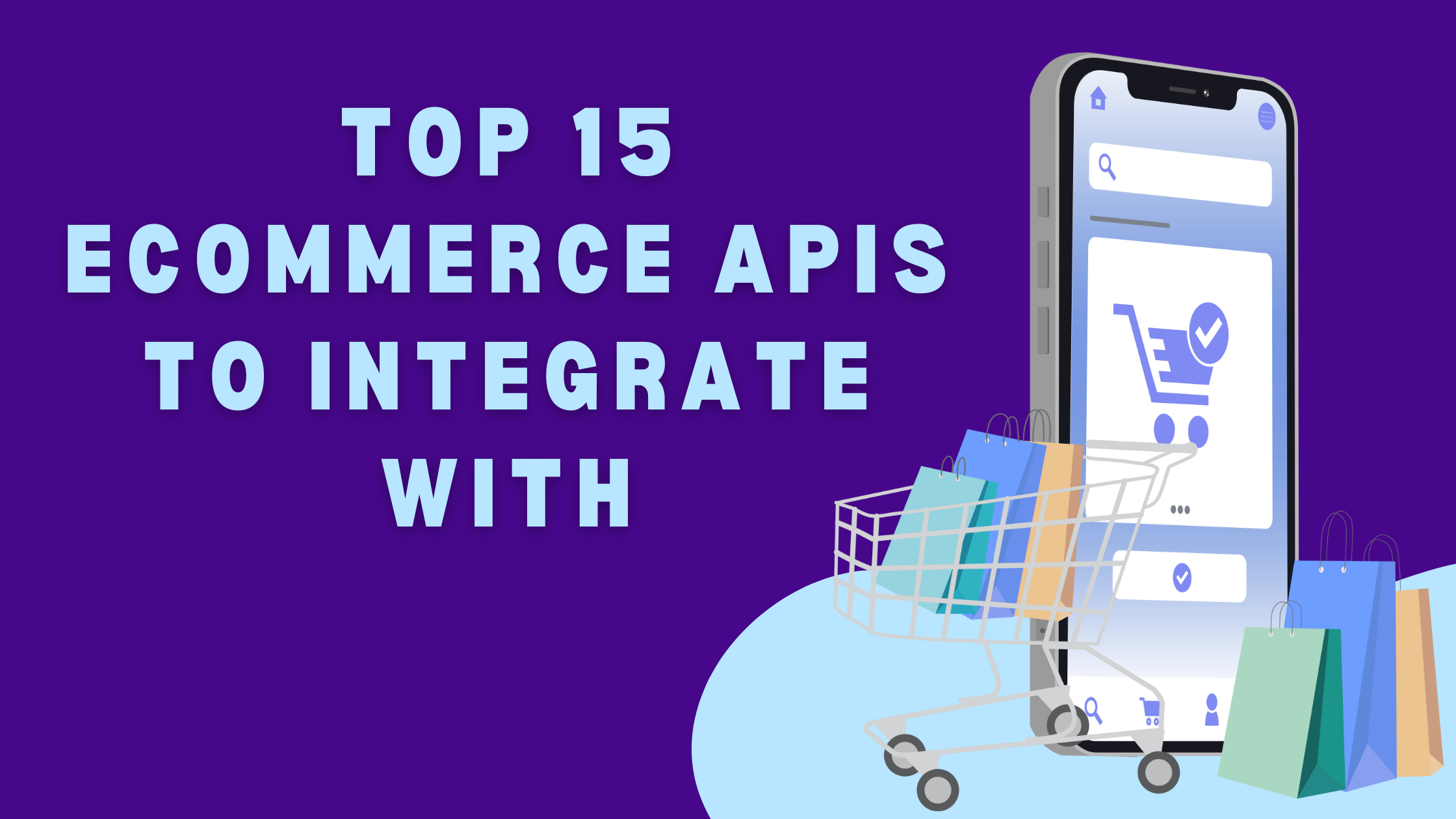Choosing the right tools can make all the difference when you're building e-commerce integrations. Your API can make or break your project. Each platform has its own architectural design and approaches to pagination, rate limits, webhooks, and object structures. Reliable, well-documented APIs make integrations more predictable, scalable, and far easier to maintain.
This article provides a quick rundown of the fifteen top e-commerce platforms and APIs you need to know about. You'll see what each one offers, who it's best for, and how it fits into different use cases, from solo entrepreneurs and small shops to large-scale enterprise retailers.
Shopify

Shopify is one of the most popular e-commerce platforms in the world. If you're building an online store, Shopify gives you everything you need to get started and grow. You can create a beautiful, custom site using their website builder and themes, hook up a domain, and start selling across channels like your own site, social media, marketplaces, and even in-person with Point of Sale.
Shopify's API is a favorite among developers—and for good reason. It's well-documented, easy to work with, and flexible. Its flexibility stems from a mature, scalable, and developer-friendly tool kit that adapts to various e-commerce use cases. It offers REST and GraphQL endpoints that let you manage everything from products and orders to customers and storefronts. It's an excellent option for building custom storefronts, syncing data across platforms, or extending Shopify's features to fit your needs.
Amazon Seller Central

Amazon Seller Central is the gateway for third-party sellers to manage their Amazon storefronts. Amazon gives you a storefront and equips you with a full suite of tools, such as product management tools, inventory and order management, pricing and promotions, and analytics and insights, among others, to help run and grow your business. You can access enterprise-level features regardless of size.
Amazon's Selling Partner API (SP-API) gives you deep access to one of the world's biggest marketplaces. You can manage listings, track orders, reconcile payments, and tap into ads and marketing features. It's more complex than most APIs, and there is a learning curve. But it's powerful if you need enterprise-level reach and want to support merchants globally.
WooCommerce

If you run WordPress sites, you'll likely need WooCommerce to power your online stores. WooCommerce's open source nature and massive install base make it essential for plugin builders and e-commerce SaaS platforms. It allows you to build and grow your online store exactly how you want.
WooCommerce offers a REST API that gives you access to orders, products, customers, and more—perfect for integrating with custom backends or apps. It's built on WordPress and highly customizable, and it works well for developers familiar with PHP and MySQL. If you're a PHP developer who understands WordPress, WooCommerce gives you complete control over the e-commerce experience from the database to the frontend. That flexibility makes it one of the most developer-friendly platforms out there. It's great for flexible projects such as headless commerce, checkout flows, and tight integrations with other systems where control is key.
Wix

Wix makes it easy to build a website that looks and works exactly the way you want—no coding needed. With its intuitive drag-and-drop builder, you can quickly add and customize everything.
Through the Velo developer platform, Wix's APIs and SDKs give you a pretty flexible setup. You can pull in and store data, connect to outside services, and build custom features that bring a site to life. This is convenient if you're working with smaller merchants who need powerful e-commerce functionality but don't want the complexity.
Wix's simplicity is great for nontechnical users, but for developers, it can feel limiting. You don't get full control over the server, routing, data, or performance, which makes building complex or large projects harder, especially if you're used to open frameworks or custom stacks.
Magento (Adobe Commerce)

Adobe Commerce is the go-to for complex e-commerce needs. It's excellent for high-volume sellers and developers building complex commerce workflows. It's a composable, API-first solution to help you build high-performing, personalized storefronts for B2C and B2B customers from a single, cloud-native platform.
Adobe Commerce API is built for extensibility and scale. It's based on REST and GraphQL, offering full access to catalog, order, customer, and B2B-specific data. It's a suitable option for large enterprises that value high customization and powerful third-party integrations.
BigCommerce

As an Open SaaS solution, BigCommerce combines the reliability of SaaS with the flexibility of a robust, API-driven architecture. So you can integrate, customize, and scale your e-commerce stack exactly as your business needs it. BigCommerce provides a developer-friendly REST and GraphQL API, with features covering store setup, catalog management, checkout, and customer profiles.
It also gives you tools like B2B suite, webhooks, open APIs, and multi-storefront management to move forward with multi-storefront setups, headless builds, or complex B2B and omnichannel operations. You'll find essential back-office integrations and a partner-friendly ecosystem that lets you extend functionality however you see fit. It's e-commerce on your terms, with the scalability and agility to grow as fast as you do.
TikTok Shop

TikTok Shop is the future of commerce, built for speed, engagement, and global reach. TikTok Shop blends content and commerce into a powerful social selling platform for today's digital-first shoppers. Quick access to TikTok's massive Gen Z audience gives you a competitive edge. Integrating is key if your users want to manage their TikTok Shop alongside other sales channels.
As a developer or technical stakeholder, you'll find TikTok Shop's e-commerce integration capabilities—like real-time webhooks, creator and affiliate integration, and in-app checkout integration—make it easier to support in-app shopping experiences and convert views into purchases, all within the TikTok ecosystem. TikTok Shop offers APIs and integration tools to automate key workflows and scale efficiently. You can manage product listings, orders, and shipping, sync inventory across platforms, and secure payments.
Walmart Marketplace

Walmart Marketplace offers exposure to millions of customers and a robust platform for developers looking to scale e-commerce operations efficiently in the USA. In recent times, developers across various forums have reported broken links, access-denied errors, and prolonged delays in generating API keys. However, Walmart has been slowly improving its developer portal and offering tools like OpenAPI specs and Postman collections to help speed up integration time.
With direct access to the Developer Portal, you can build customized workflows, automate key operations, and effortlessly integrate your systems. Use Walmart Fulfillment Services for scalable logistics, promote products with Walmart Connect's advertising tools, and protect your brand through the dedicated Brand Portal.
Etsy

Etsy is a vibrant marketplace built around independent creators and small businesses. It focuses on handmade, vintage, and one-of-a-kind items, which means sellers get access to a loyal, niche audience.
If you're a developer or part of a tech team, Etsy provides solid API tools for listing management, inventory control, shop information, and more to keep everything running smoothly as you scale. Instead of building product management, order handling, and inventory logic from scratch, Etsy's API lets you plug into a ready-made ecosystem. It's beneficial if you're creating SaaS tools for merchants, integrating multichannel sales, or automating operations.
Based on discussions in developer forums and communities in recent years, some recurring challenges—such as restrictive API access and approval process and deprecation of key endpoints—have been identified by developers working with Etsy's API. Etsy has taken steps to address these developer concerns by updating its official API documentation and establishing clear rate limits for API usage.
Lightspeed (Retail POS)

Lightspeed Retail POS gives you complete visibility and control over inventory, sales, and customer data from a single cloud-based platform. It has built-in tools for inventory management, payments, and e-commerce.
Lightspeed's Retail POS API is designed for brick-and-mortar stores that are going digital. Developers can fully utilize it to build customized workflows, integrate with essential third-party tools, and tailor the platform to unique business needs. In addition, you can scale confidently with features like real-time insights, multilocation management, and supplier integration through Lightspeed NuORDER.
Lightspeed eCom (E-Series)

Lightspeed eCom (E-Series) helps you quickly launch a professional-looking online store with one of thirty customizable themes. While Lightspeed Retail focuses on POS, eCom supports full online storefronts. You can manage everything from one dashboard, including orders, inventory, pricing, promotions, and omnichannel operations.
Lightspeed eCom API is a fairly structured RESTful interface geared toward managing products, orders, customers, and web store content. If you're planning deep customizations or multiplatform integrations, you might find it a bit restrictive, but for standard use cases like syncing product data or managing orders, it does the job. It's especially useful when paired with Lightspeed Retail as their ecosystem integrates well across POS and eCom. Lightspeed eCom's API is ideal for omnichannel businesses that want a unified view of their online and offline sales activity.
Picqer

Picqer is a warehouse management system built specifically for e-commerce businesses. If you run an online store and need to improve your warehouse operations, Picqer API is your solution. It helps simplify logistics and manage everything, from inventory to picking and packing. Picqer API offers a comprehensive, developer-friendly RESTful interface and extensive documentation to streamline warehouse management tasks.
You can manage your entire warehouse from one intuitive platform—track inventory by location, receive competent purchasing advice, streamline pick and pack processes, and handle shipments and returns with just a few clicks. You'll save time daily and process up to five times more orders. Plus, with seamless integrations for your online store, shipping partners, and customer support tools, Picqer keeps everything connected so your logistics run like clockwork.
Mollie

Mollie handles payments, subscriptions, and payouts for European merchants. With Mollie, you can streamline how your business gets paid online and in person without needing a team of developers or a complicated setup. It handles payments, subscriptions, financing, fraud protection, and reconciliation. You can accept secure payments online, set up physical payment terminals in just a few clicks, and send custom payment links on any channel.
You'll also love how easy it is to integrate Mollie into your current setup. With prebuilt plugins for popular e-commerce platforms and developer-friendly libraries in languages like JavaScript, PHP, .NET, and Python, connecting Mollie to your tech stack is a breeze. Mollie provides a payments API that supports online and in-person transactions, subscriptions, financing, reconciliation, multicurrency transactions, and instant refunds.
PrestaShop

PrestaShop is a flexible, open source e-commerce platform that gives you complete control over building and growing your online store. Like Mollie, it is also popular across Europe. PrestaShop gives developers the tools to create a store that's uniquely yours. With its modular architecture and access to thousands of add-ons, you can tailor everything, from product pages and checkout flows to payment integrations and shipping options.
PrestaShop's API allows developers to manage products, orders, carts, customers, and more through a RESTful interface. The default API can feel outdated compared to newer platforms. This is because it still uses older formats like XML and doesn't offer modern features like GraphQL or flexible filtering. It works, but for more complex needs, developers often have to build custom add-ons or extra logic to make it easier to use.
PrestaShop supports various payment and shipping carriers, multilingual and multicurrency capabilities, and integrations with leading marketing and analytics platforms. From one centralized back office, you can manage your catalog, track inventory, process orders, and optimize your store's performance.
Shopware

Shopware is an open commerce platform that gives developers a strong set of tools to build and customize every part of an e-commerce store. You can access modern tools like headless-ready API (REST and GraphQL), a powerful plugin system, and a flexible theming engine for customizing storefronts. It is built with a scalable backend (Symfony) and a modern, reactive frontend (Vue.js). Shopware also includes rule-based pricing and promotions, a built-in CMS (Shopping Experiences) for content control, and a developer-friendly admin panel.
Thanks to an event-driven and service-oriented design, you can easily access a rich plugin ecosystem or create extensions. Shopware also excels in omnichannel and international scenarios, offering out-of-the-box multistore and multicurrency support. Its API-first architecture, well-documented REST API (with Swagger/OpenAPI support), and GraphQL extensions make Shopware a strong choice for modern commerce.
Integrating with Apideck
If you're building tools, platforms, or services that need to interact with these systems, chances are you won't just be working with one. Many real-world use cases—like enabling multistore support, powering integration marketplaces, or serving clients on different platforms—require your product to talk to several APIs simultaneously.
It's no secret that every platform has its quirks, authentication flows, data formats, rate limits, and documentation (some more polished than others). Integrating each one individually can quickly become a nightmare. You'll burn through developer hours just trying to maintain parity across all of them, and that's before updates or breaking changes kick in. For that, you'll need a single integration layer to handle it all.
Instead of building separate, point-to-point connections for every e-commerce, HRIS, or CRM platform, Apideck solves this headache through its Ecommerce Unified API. Imagine your customers selling on all these platforms and you have to integrate all fifteen of these APIs individually. You'd face weeks or even months of development, maintenance nightmares, and increased third-party liability.
That's why Apideck's Ecommerce Unified API is such a big deal. You can connect to all of these platforms through a single integration. That means your team has to build and maintain only one integration, and you immediately open the door to every store your customers might use. You save time, reduce ongoing maintenance, and get to market faster. The following are its key features:
- One-off integrations: Save months of dev work.
- Real-time data: No delays from caching layers.
- Usage-based pricing: Pay only for what you use.
- Global platform coverage: One integration, global reach.
- Better security: Not storing sensitive user data reduces the risk of leaks.
- Encryption: Protect sensitive data at rest and in transit.
These standout features result in real-time data without caching delays, enhanced security since no data is stored (reducing liability), and flexible, usage-based billing that lets you control costs more precisely. They offer a more innovative and secure way to scale your integration strategy. Instead of hiring a team to wrestle with API chaos, your developers can focus on delivering actual product value.
Apideck supports these platforms because they represent the industry's most widely used, high-impact venues and are critical for businesses that want to grow and serve merchants at scale.
Wrapping Up
This article covered the fifteen top e-commerce platforms, from Shopify and Amazon Seller Central to TikTok Shop and Shopware. Each platform brings its own set of capabilities for managing products, inventory, orders, payments, and storefront experiences. But in practice, most businesses don't stick to just one. You might be selling on multiple channels, working with clients using different platforms, or building tools that connect to several storefronts. Building and maintaining these integrations individually can quickly become a heavy lift for your engineering team.
Instead of juggling dozens of unique APIs, let Apideck's Unified APIs allow you to build native integrations faster through a single, scalable interface. They're available as a simple REST API, so you can focus on building your product.
Ready to get started?
Scale your integration strategy and deliver the integrations your customers need in record time.








